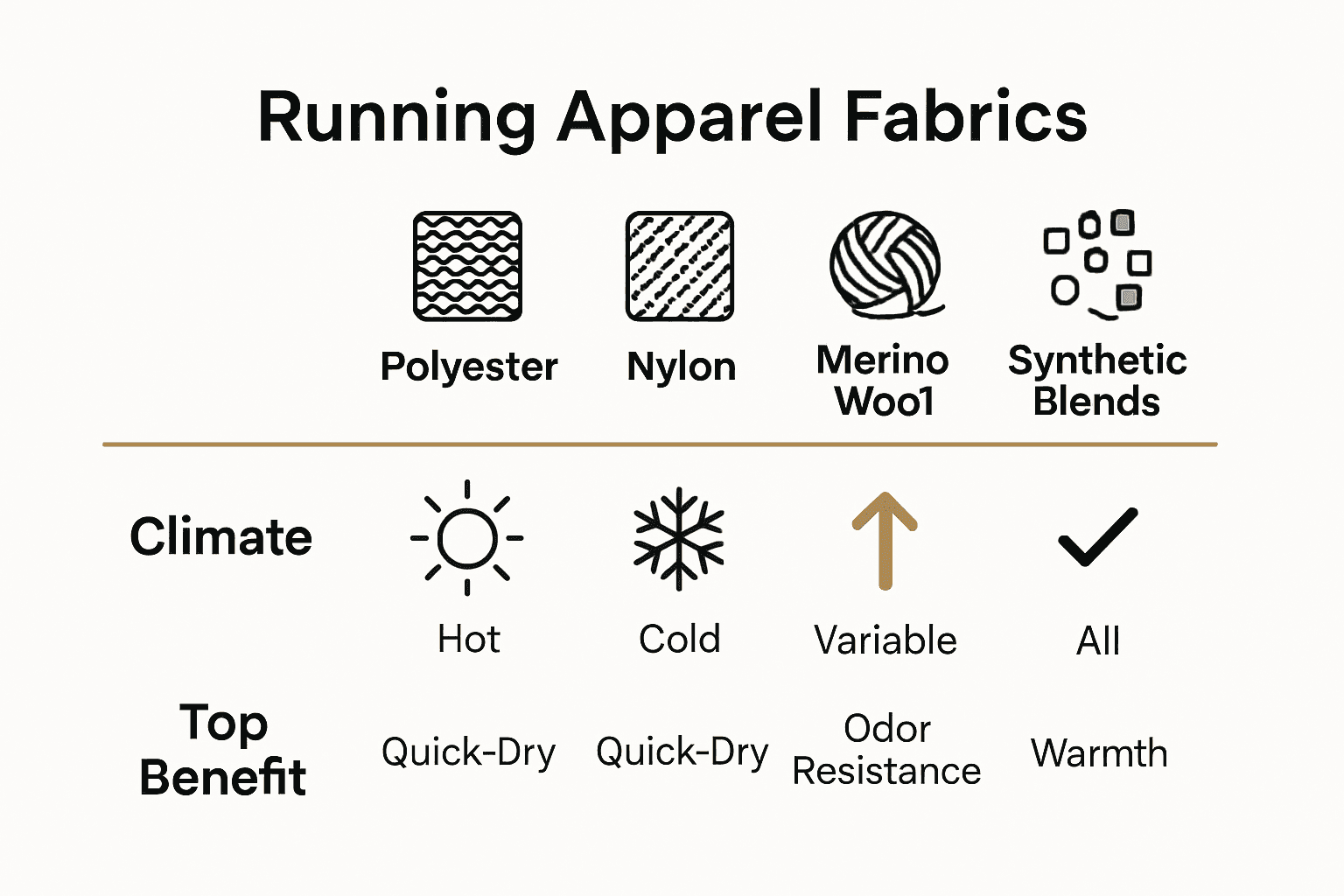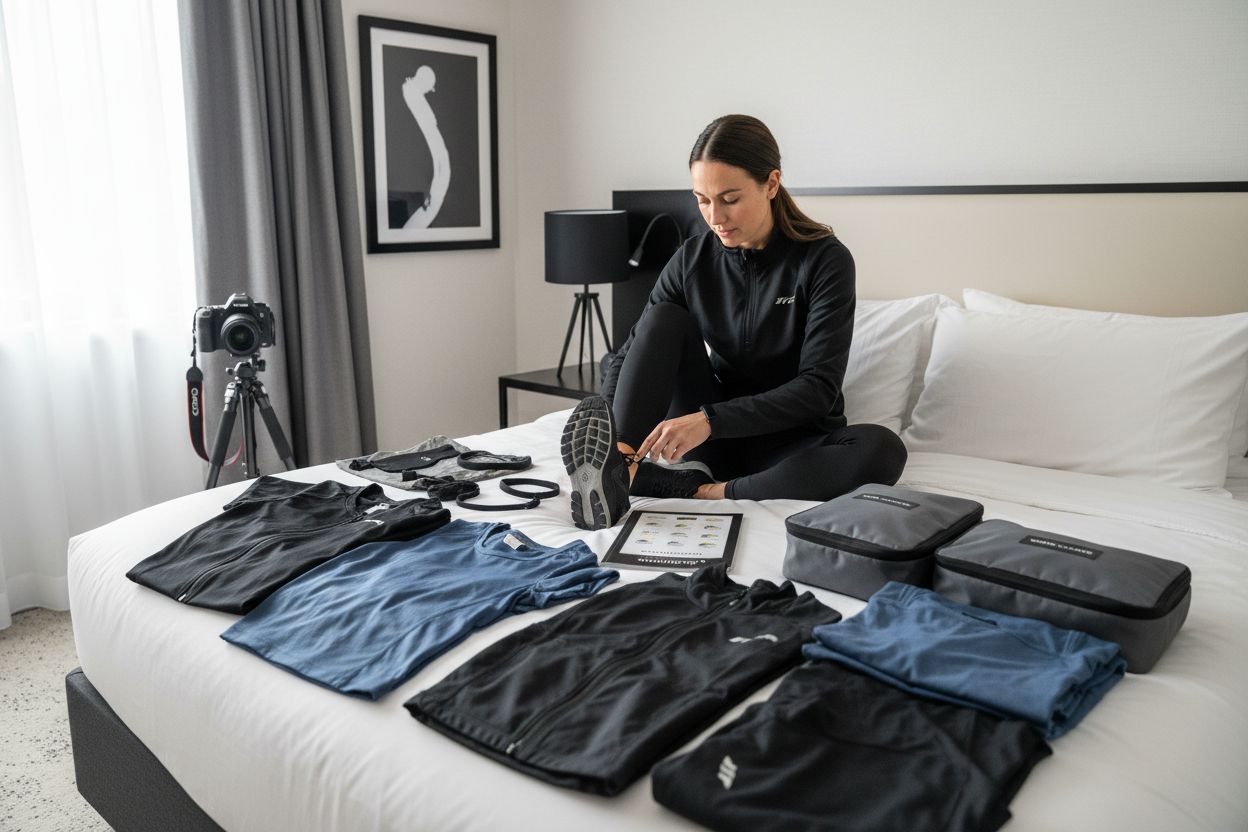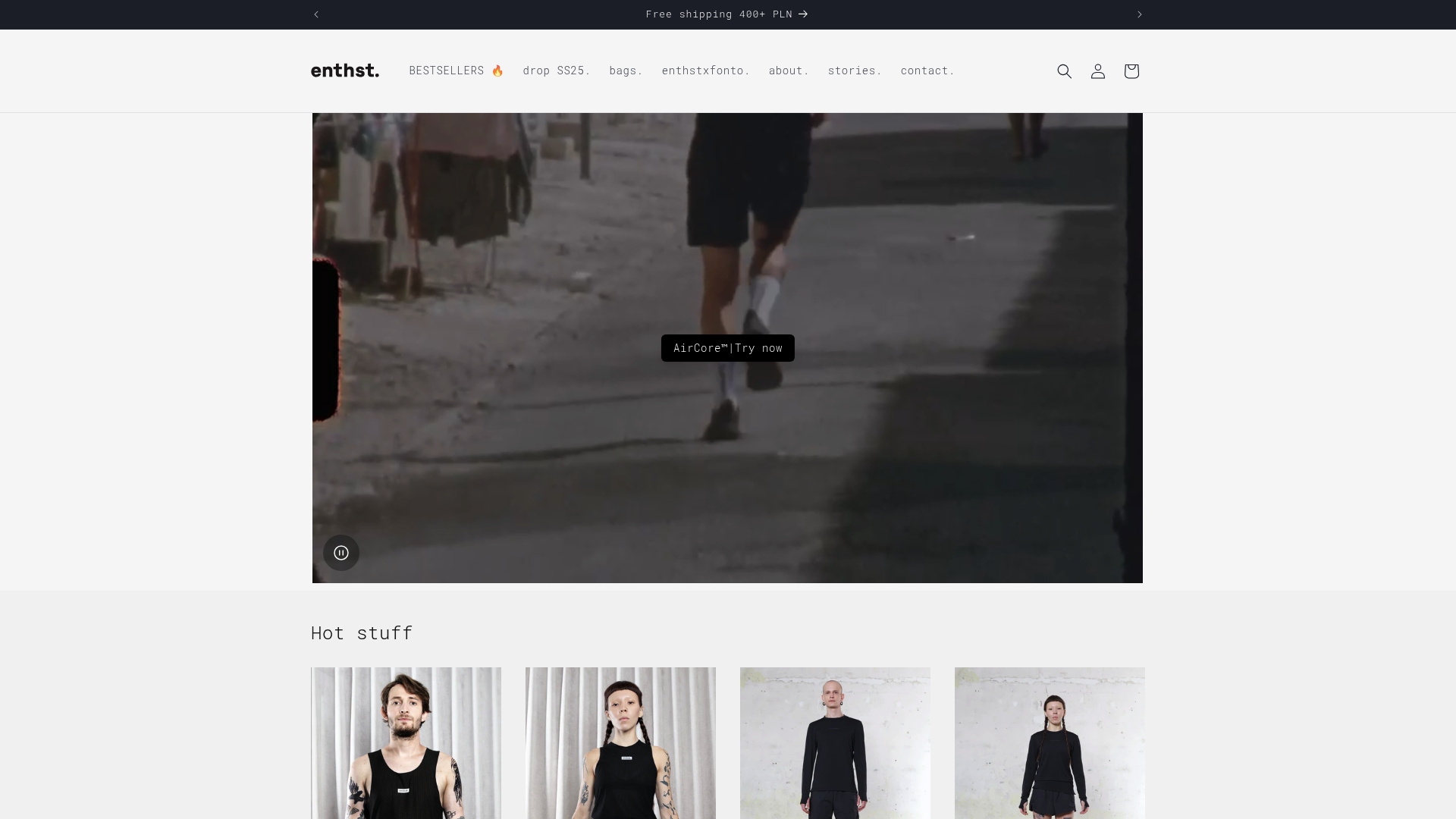
How to Choose Running Gear for Travel: Step-by-Step Guide
Share
Did you know that over 60 percent of runners experience discomfort on the road simply because they packed the wrong gear? Picking the right clothing and equipment can make all the difference in whether your travel runs leave you feeling energized or frustrated. Your choices matter as temperatures shift and weather throws surprises at you in unfamiliar places. With smart planning and a few key tips, you can set yourself up for stress-free, comfortable runs no matter where you travel.
Quick Summary
| Key Point | Explanation |
| 1. Research climate before packing. | Understand your destination’s weather patterns to select suitable running gear and clothing layers. |
| 2. Choose versatile, lightweight apparel. | Opt for ultralight, quick-dry materials that are easy to pack and adaptable for different environments. |
| 3. Test gear performance in advance. | Ensure that shoes and running gear meet performance demands by testing them under similar conditions before your trip. |
| 4. Pack efficiently for easy access. | Organize gear for quick access and maximize space utilization while keeping essential items readily available. |
| 5. Verify comfort and readiness of gear. | Conduct a comfort check on all gear and ensure everything functions correctly to avoid surprises during your runs. |
Table of Contents
Step 1: Identify travel destination and climate needs
Choosing the right running gear starts with understanding your travel destination’s unique environmental conditions. This critical step ensures you pack smart and stay comfortable while maintaining your running routine.
Begin by researching your destination’s typical weather patterns during your travel dates. According to KU Leuven Sport, checking the weather forecast is crucial for regulating temperature and selecting appropriate clothing layers. Whether you are heading to a humid tropical region or a cool mountain climate, your preparation determines running comfort.
Temperature variations dramatically impact your gear selection. In Southern European destinations where temperatures can soar to 28-35 °C, Running Expert recommends running during early morning hours and prioritizing UV protective gear. This means packing lightweight breathable clothing, sunglasses, and strong sunscreen.
Consider fabric choices carefully. Moisture-wicking materials like polyester, nylon, and merino wool work best across different climates. For warm environments, choose lightweight breathable pieces. In cooler regions, plan for layering options that allow temperature regulation during your runs.
Here’s a quick comparison of fabric choices for different climates and running needs:

| Fabric Type | Best For | Key Benefits |
| Polyester | Warm & humid | Lightweight Moisture-wicking |
| Nylon | Variable climates | Quick-dry Durable |
| Merino Wool | Cool & mixed | Odor resistance Temperature regulation |
| Synthetic Blends | All climates | Multi-season versatility Comfort |
Pro Tip: Always pack versatile pieces that can be mixed and matched across different weather conditions to maximize your limited travel packing space.
Next, you will assess specific gear requirements based on your destination’s terrain and expected running conditions. This preparation ensures you are ready for any running adventure your travels might offer.
Step 2: Select versatile and lightweight apparel
Now that you understand your destination’s climate, it is time to choose running gear that adapts seamlessly to different environments while keeping your luggage light and functional. Your goal is to pack smart with versatile pieces that perform across multiple conditions.
According to Minimalist Journeys, focus on ultralight and quick-dry materials that offer breathability and packability. Look for running shorts and shirts made from technical fabrics that dry rapidly and resist wrinkles. As Danish Endurance suggests, prioritize clothing that packs down small without compromising performance.
Key characteristics of travel-friendly running apparel include moisture-wicking properties, compact design, and multi-season versatility. Seek out lightweight jackets that provide wind and rain protection without adding significant bulk to your luggage.
 Consider pieces with reflective elements for added safety during early morning or evening runs in unfamiliar environments.
Consider pieces with reflective elements for added safety during early morning or evening runs in unfamiliar environments.
Think strategically about layering. A compact running gilet or lightweight thermal layer can transform your basic running outfit, allowing you to adapt to temperature shifts without packing multiple bulky items. Merino wool and synthetic blends work exceptionally well for this purpose, offering temperature regulation and odor resistance.
Pro Tip: Select neutral colored pieces that can be mixed and matched easily, maximizing outfit combinations while minimizing packed items.
Your next step will involve selecting specific pieces that meet these versatility criteria and match your planned running routes and expected weather conditions.
Step 3: Test gear for technical performance
Before hitting the road on your running adventure, you need to verify that your selected gear meets the technical demands of your planned routes and travel conditions. Technical performance testing ensures your equipment will support you reliably during your journey.
According to KU Leuven Sport, your gear selection should directly align with your specific terrain and running goals. This means thoroughly testing shoes for appropriate shock absorption on long routes or grip capabilities for trail running, which can significantly impact performance and injury prevention.
Start by simulating travel conditions during your pre-trip gear testing. This includes checking GPS accuracy on running devices. As Runner’s World lab tests demonstrate, even budget devices can offer impressive accuracy within 0.01 to 0.03 miles when properly evaluated. Run multiple test routes to confirm your equipment’s reliability.
Evaluate each piece of gear systematically. Check moisture-wicking capabilities of shirts and shorts. Test jacket waterproofing. Verify electronic devices maintain battery life and connectivity. Pay special attention to how different fabrics and technologies perform under varying temperatures and humidity levels.
Pro Tip: Always test new gear on multiple shorter runs before your trip to identify any potential comfort or performance issues.
Your next step will involve creating a comprehensive packing list that incorporates your technically tested running gear, ensuring you are fully prepared for your travel running experience.
Step 4: Pack efficiently for easy access
Efficient packing is an art form for runners traveling with limited space and maximum performance needs. Your goal is to organize gear strategically, ensuring quick access and maintaining the functionality of your running equipment.
Intentional Runner recommends using a dedicated lightweight shoe bag to separate your running shoes from other items. This approach not only keeps your other clothes clean but also provides easy access to your most important piece of running gear.
According to RunningXpert, smart packers focus on versatility and reusability. Choose quick-dry underwear and shorts that you can rinse and reuse overnight. This technique dramatically reduces the amount of clothing you need to pack, leaving more room for essential gear.
Consider your packing strategy carefully. Use compression bags or packing cubes to maximize space and keep items organized. Place heavier items like shoes at the bottom of your bag, with lighter technical clothing layered on top. Pack your running outfit and a spare set in an easily accessible compartment so you can quickly change upon arrival at your destination.
Pro Tip: Pack compression socks in your carry-on to help with recovery during long flights and ensure your legs stay fresh for running.
Your next step involves creating a final checklist to confirm you have not forgotten any critical running gear for your travel adventure.
Step 5: Verify gear comfort and readiness
As you approach your travel running adventure, the final crucial step is ensuring every piece of gear feels comfortable and performs perfectly. Your goal is to eliminate potential discomfort or technical surprises before you hit the road.
According to KU Leuven Sport, shoe comfort is paramount. Do not make the mistake of prioritizing appearance over fit. Your running shoes must feel perfect and be thoroughly broken in before your trip. They should match both your planned terrain and expected running distances to minimize injury risk.
Runner’s World testing highlights the importance of verifying technical gear performance. Even familiar devices like GPS watches can have surprising variations in accuracy. Schedule multiple test runs with your equipment to confirm reliability and functionality.
Conduct a comprehensive comfort check. Wear your planned running outfit on several training sessions that simulate your travel conditions. Pay attention to how fabrics feel against your skin, check for potential chafing points, and ensure all electronic devices sync and track data accurately.
Test your gear in conditions similar to your destination temperature and humidity.
Pro Tip: Always pack a small repair kit with safety pins, athletic tape, and extra shoelaces to address unexpected gear issues during your trip.
Your next step involves mentally preparing for your running adventure and visualizing successful runs in your new destination.
Elevate Your Travel Runs with Technical Innovation and Streetwear Style
Packing for a running trip can feel overwhelming when you need gear that meets technical performance demands, adapts to different climates, and is light for travel. This article showed how hard it can be to balance moisture-wicking fabrics, fit for changing weather, and comfort tested on real runs. If you do not want to risk discomfort, packing mistakes, or gear that does not suit your adventurous routes, it is time to discover solutions built for these challenges. Explore the collection S25 at Enthst.com. Each piece is designed for travelers who demand both technical excellence and modern street style. Our apparel and accessories are tested by professional athletes and passionate runners, so you can trust every product to perform in any travel destination.

Ready for worry-free packing and effortless style on your next journey? Choose the right gear now at Enthst.com or browse our bestsellers to experience the comfort and confidence that only a dedicated running community can deliver. Get the edge on your travel runs and set off fully prepared.
Frequently Asked Questions
How do I identify the right running gear for my travel destination?
To choose the right running gear for your travel destination, start by researching the typical climate and weather patterns. Gather information about temperature and humidity levels to select appropriate clothing materials, such as moisture-wicking fabrics for warm environments.
What types of fabrics should I look for in travel-friendly running apparel?
When selecting running apparel for travel, prioritize lightweight and breathable materials like polyester and merino wool. For cooler climates, opt for layers that provide temperature regulation, ensuring all your pieces can be easily mixed and matched.
How can I efficiently pack my running gear for travel?
To pack your running gear efficiently, use packing cubes or compression bags to save space and keep your items organized. Place heavier items like shoes at the bottom of your bag, and keep your running outfit accessible for easy changes upon arrival.
What should I test before using my running gear on a trip?
Before your trip, thoroughly test each piece of running gear for comfort and performance. Conduct several shorter runs in your selected shoes and outfits to check for fit and to identify any potential discomfort or technical issues.
How do I ensure my running shoe fits properly for travel?
To ensure your running shoes fit properly, prioritize comfort over appearance and break them in with multiple runs. Choose shoes that suit your planned terrain and distances to reduce the risk of injury.
What action should I take if I experience discomfort with my running gear?
If you encounter discomfort with your running gear, conduct a comprehensive comfort check by simulating your travel conditions. Make adjustments as needed, such as trying different clothing layers or using protective measures like chafing balm to enhance comfort.